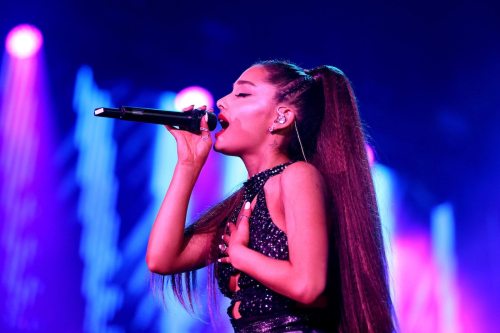Ariana Grande’s brain scan shows her PTSD—but we shouldn’t need to see it to believe it
With news of Ariana Grande's brain scan as visual evidence of PTSD, the internet snapped to attention. But invisible disorders deserve the spotlight, too.

Ariana Grande is constantly surpassing her own boundaries. She breaks her own records in the music industry, yes, but her triumph is set to the tune of a cultural consciousness. Last summer, the singer first spoke publicly about her struggles with post-traumatic stress disorder (PTSD) in the aftermath of a 2017 bombing at her concert in England, which claimed lives of 22 people. In the time since, Grande has shown courage and stamina by practicing mental health transparency with her fans.
In sharing her trauma, the 25-year-old pop icon displayed fierce vulnerability. “I don’t think I’ll ever know how to talk about it and not cry,” she told British Vogue at the time. Yesterday, in a coup for everyone (not just celebrities) pushing mental health into the spotlight, Grande took to Instagram to display the physical imprint that PTSD leaves on the brain. A series of brain scans, including her own, displayed the very visual consequences of PTSD, reports Refinery29. The photos are arresting; “hilarious and terrifying,” Grande called them.
The internet snapped to attention when Grande shared the scans. In the mental health conversation, such observable evidence can help to banish stigma—clearly something is “wrong,” we can see it right there on the screen. The next step is accepting that the whole gradient of mental wellness isn’t so visible. In fact, much of it is invisible. And we need to learn to “believe” mental illness—even without visual proof.
Making psychiatric diagnoses through brain imaging is endlessly challenging, explains cognitive behavioral psychologist Seth J. Gillihan, PhD, in Psychology Today. The disorders present themselves differently in each individual, in varying locations throughout the brain, and with symptoms that are indicative of any number of diagnoses. The effects of PTSD show up prominently in the amygdala, or fear center of the brain, but in most cases, a disorder’s trace isn’t so easily identifiable. “While science hasn’t enabled brain-based diagnosis in psychiatry, the ‘old fashioned’ approach—talking with a mental health professional—still works,” writes Dr. Gillihan. Diagnosis is a dialogue. One that can sometimes be communicated in pictures, but is most often told with words.
Taken in its most shame-smashing form, Grande’s scan (which she blasted out to 1.5 million followers) is an appeal for us to acknowledge—to see—mental health conversations through collective empathy. Unseeable mental plights may not show up underneath hospital lights or in the frames of an Instagram story, but they’re tangibly felt in frank discussions with one another. A 2015 study found millennials to be more accepting and understanding of mental illness purely because many of them grew up in environments where conditions like depression, anxiety, eating disorders, and suicide were spoken about freely. Members of Gen Z, too, are acutely aware of their own mental state. In fact, a survey from late 2018 found that people from this generation (born in the late 1990s and early 2000s) are more likely to report mental health conditions than any other, according to CNN.
“Many of my clients joke that they and their co-workers often start conversations with, ‘My therapist thinks…’” clinical psychologist Elizabeth Cohen, PhD, tells The Wall Street Journal. “The shame of needing help has been transformed to a pride in getting outside advice.” Right now, in this very moment, we are on the cusp of a mental health movement that happens right out in the open. One that makes headlines just as quickly as a chart-climbing single. And each of us possess the freedom and courage to share our personal struggles. Ariana Grande proves it time and time again.
She taught me love. She taught me patience. And now she’s showing us how she handles her pain. That shit’s amazing (even if you can’t see it).
If you or someone you know needs support, please contact the National Alliance of Mental Health at 1-800-950-6264 or [email protected].
While we’re on the subject of the world’s top pop diva, here’s how she gets her best song ideas at the gym. And the essential oils she uses to achieve those slick, shiny locks.
Sign Up for Our Daily Newsletter
Get all the latest in wellness, trends, food, fitness, beauty, and more delivered right to your inbox.
Got it, you've been added to our email list.










